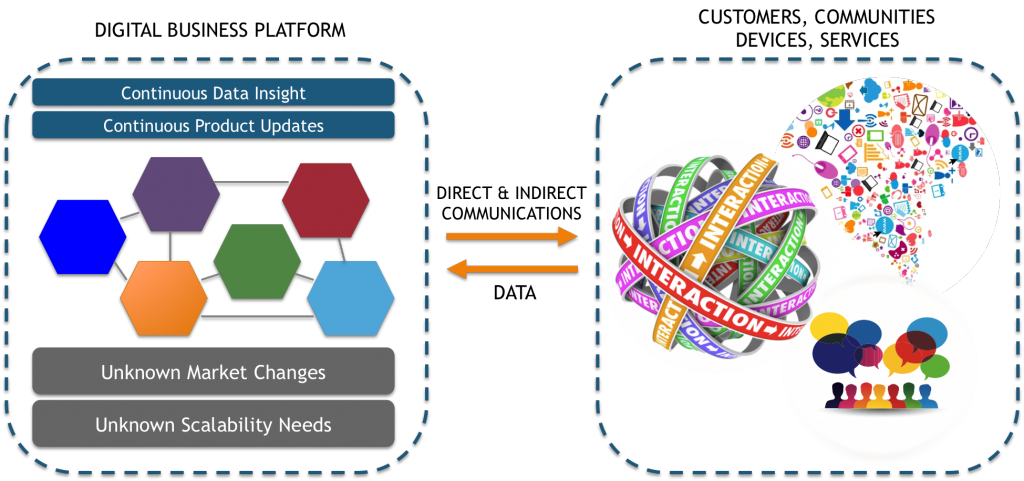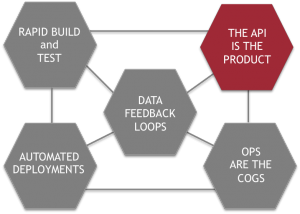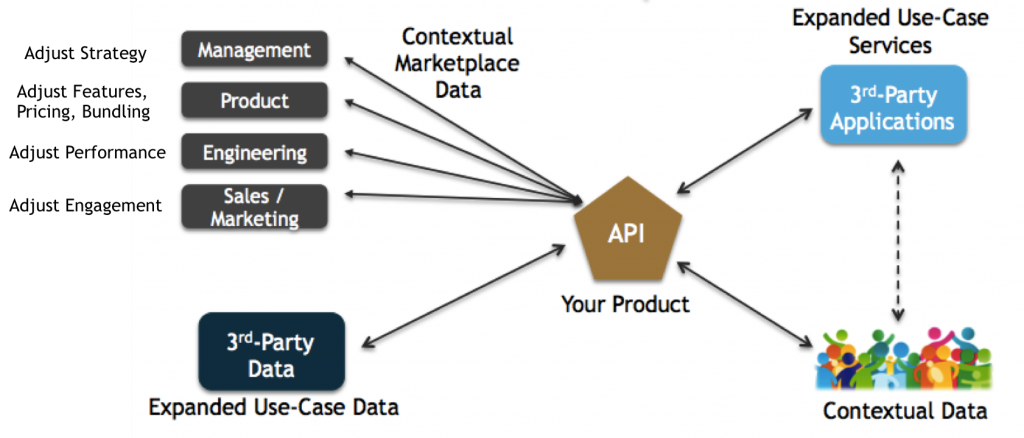This research is part of five reports looking at the alignment of business and technology within a Digital Business Platform. Other reports will focus on Digital Feedback Loops, how the API is the Product, Rapidly Building and Deploying Applications, Automated Deployments, and Controlling the Operational COGS.]
Premise: Modern business is evolving to a point where the interaction between companies and the marketplace has become a set of programmatic, digital interfaces. This evolution goes well beyond eCommerce websites, and is expanding into a rich set of APIs (Application Programming Interfaces) that are becoming the digital face of the company. These APIs not only deliver more robust experiences, but are built upon in-depth data and analytics. This API-centric model is forming the foundation for Digital Business Platforms that allow continuous product and service updates to the marketplace.

Business are using coherent digital interfaces to interact with marketplaces in ways that were never possible before. An initial approach was to use digital technologies to provide multi-channel communications with customers, partners, devices and data to provide an expanded view into opportunities, challenges and areas for business optimization. Now, companies are extending digital interfaces directly into offerings, evolving their focus from digital channels to rich digital customer experiences that span the entire customer lifecycle. The evolution of digital engagement will require executives to evolve their approaches to running their business because:
- The API (or set of APIs) is the Product. To a customer, the product is what they get out of an offering, and not the package that is offered. The API can refine a product’s qualities in response to direct, multilateral, and contextual interactions in the marketplace. 94Fifty is using its API to transform a commodity like a basketball into a community focused on developing basketball skills. Sensors in their balls interact with 94Fifty’s API to track shot make/miss, arc, distance, dribbling force, and other measures of basketball skill. This information can be shared among friends, trainers, and coaches, showcasing the capabilities of the company and highlighting new and creative brand interactions.
- The API enables multi-functional visibility into a data-centric view of the business. The API becomes the direct digital channel between the business and the marketplace. This real-time access into the market delivers new insight for many groups within a business; data that was often previously silo’d or shared in non-contextual manners. This allow the business to have parallel views into market actions.
- Platforms must be extensible to manage unexpected market opportunities. The API should have the ability to include areas of experimentation, to test new theories in real-time, with real-marketplaces. Machine Learning and Analytics will augment this, but direct validation of new product functionality should be included.

The Product is Programmable – The API as the Product
In 2015 owners of a Tesla Model S were given autonomous driving capability via an over-the-air (OTA) software update. In contrast, owners of a Honda Odyssey were sent a written letter asking them to visit a local dealership and have their in-dash mapping software updated manually. In both cases, the customer was interacting with a world-class automotive company. In both cases, the item that delivered revenue to the company was a physical good, a means of transportation. But the former example highlights a company prepared for a digital future, and the latter a company that must plan a transition to survive in the future. This contrast highlights the difference between companies that are prepared to continuously update their digital products and services and companies that are still thinking about physical goods and services.

The Tesla example is one of thousands of examples of companies that now represent themselves to the digital marketplace as much with their brand as they do with their APIs. This API Directory shows how programmability is impacting the economy from government agencies to mining companies to aircraft suppliers to university research to individual artists, and everywhere in between. And in a global economy, these institutions and individuals are becoming more and more interconnected every day. As they evolve their businesses to become more digital, they become more dependent on the evolution of their partners, as well as data-centric feedback from their markets. This is now possible because a core element of their business is API-driven.
Through APIs, companies can not only collect information directly from the market, but also indirectly as their API is combined for use in additional services. For example, travel companies will be able to track traffic patterns and availability of ride-share services to inform their customers if they need to call an Uber earlier if there is a risk of not arriving at the airport on-time. In another example, a retail pharmacy can begin to track weather data and social media activity to understand when cold season is beginning in a certain region of the country and adjust inventory levels to better serve local communities.
VIDEO: Venture Capitalist Ryan Floyd talks about how applications are shifting from being managed by IT organizations to simply being an API that can be consumed directly, or integrated into a set of other business applications.
Contextual Data Sharing – For Value Capture and Business Insight
Whether a company is focused on the challenge of delivering products and services to a marketplace, attempting to solve a complex research problem, or attempting to keep a local community safe, the information collected over the API can be viewed in many different contexts within the company. Leadership, Marketing, Sales, Engineering and Operations can all have different views of what data means to their particular organization, and it’s critical that companies are able to share information freely in fast-moving digital environments.

The simplicity of the API delivers value directly to the marketplace, allowing them unrestricted access to products and creative ways to create new add-on services. For the business, the API becomes the digital starting point for real-time access into the market. The API becomes the trigger-point for a series of data feedback loops that bring insight across the business.
In the $2T IT industry, between 5-15% of revenues are spent on Research and Development, with the goal of augmenting the roadmap of products in a differentiated manner. The challenge with roadmaps is that product team must be able to forecast market demands 12-18 months ahead of time, often with limited or outdated data. For IT vendors, it is not unusual for the majority of their customer base to be 2-3 major releases behind and only using 20-25% of the available software features. This gap between “available innovation” and “deployed innovation” is partially driven by customer risk-management, but it’s also driven by information asymmetry – driven by intermediary groups between vendors and customers (e.g. VARs, System Integrators, etc.). By building more direct digital interfaces between the vendor and customer, companies like AWS (Amazon Web Services) and Pure Storage have been able to significantly penetrate establish segments of the IT market.
For AWS, they are able to collect usage reports to understand which services are the most popular and how various services are used together. Their APIsI gives IT organizations frictionless access to their IaaS/PaaS/Data services. It completely changed the paradigm of how IT is provisioned and consumed. This data gather from the APIs is then shared across product teams and operational teams to help influence pricing models, product roadmaps and future infrastructure purchases. This allows AWS to be more responsive to actual customer demand vs. perceived competitive threats.
For Pure Storage, they use integrated “call home” functionality in their storage arrays to detect unusual usage patterns. While this is typically used to deliver proactive customer-support, it can also be used to identify when a customer proof-of-concept is being manipulated. Pure Storage found that by monitoring this activity, they could intercept competitive threats and proactively apply field resources to help improve their sales conversion rates.
Managing the Unexpected – Building for Strategy, Roadmap and Uncertainty
While there are many tools and frameworks to enable a company to deliver an API-centric product to market, there is the equally challenging task of having a responsive organization behind it to take advantage of market insights. This is where organizational dynamics play a crucial role to any digital transformation. Successful product teams must have a Digital Business Platform that allow experimentation with new offerings, as well as augments human decision-making with machine-learning and artificial intelligence capabilities. Just as physical product companies relied heavily on ERP systems to manage workflows, digital companies will rely on a new set of tools to enable them to manage their products.
For many companies, the transition to Digital Business Platform is a threat, a challenge and an opportunity, all at the same time. This is why bi-modal approaches are often flawed, because they limit the ability for companies to transition through those phases, both individually and in parallel. Successful companies employ a model that is more situationally aware, aligning closer to Pioneers, Settlers and Town Planners.
An example of this parallel transition is ESPN. Faced with a loss of 7M subscribers due to “cable cord-cutting”, ESPN was challenged with potentially huge losses of revenues. The good news for ESPN is that sports is still considered high-priority viewing content and customers expect to watch it in real-time, unlike many other shows which are being relegated to DVRs and video snippets on YouTube or Facebook. The bad news for ESPN is that the have contracts with cable companies which prevent them from exclusively streaming their content directly to customers that are cord-cutters. So while the transitions within the market occur, ESPN has taken an interim digital step and moved all of their content to the WatchESPN mobile application. This allows ESPN to continue to maintain their existing business model via cable and satellite providers, but also experiment with the digital mobile experience.


